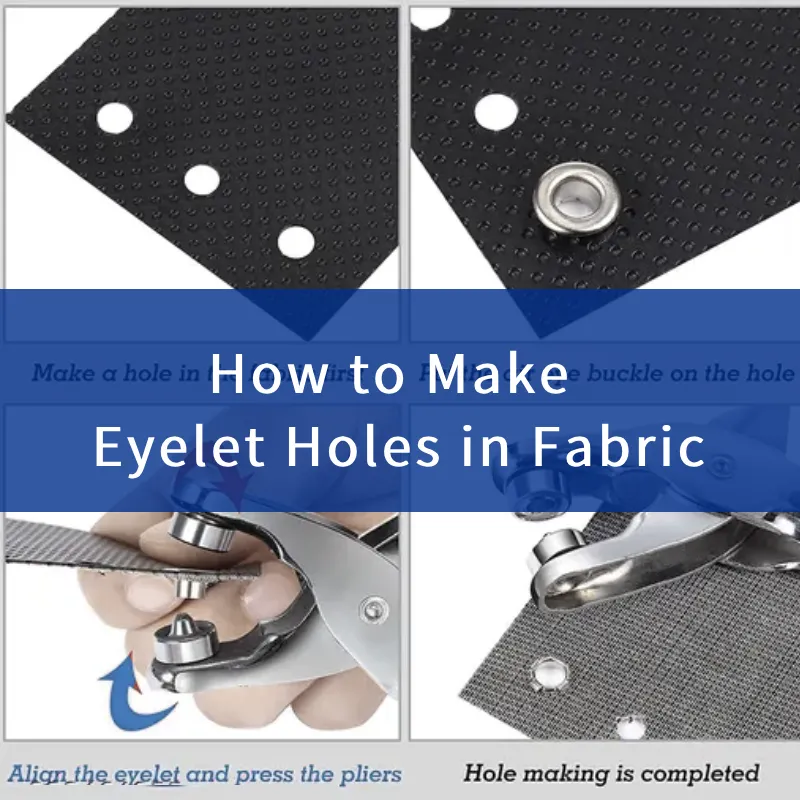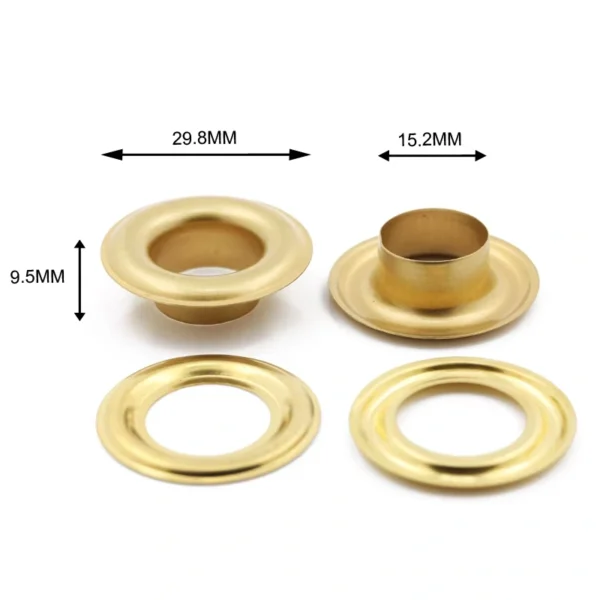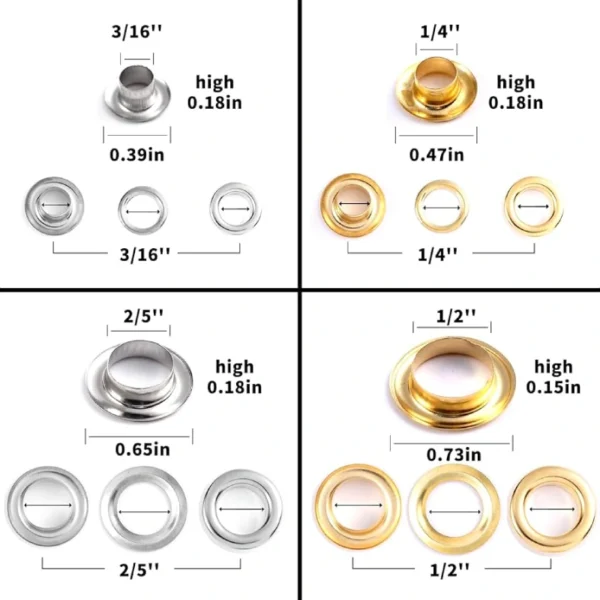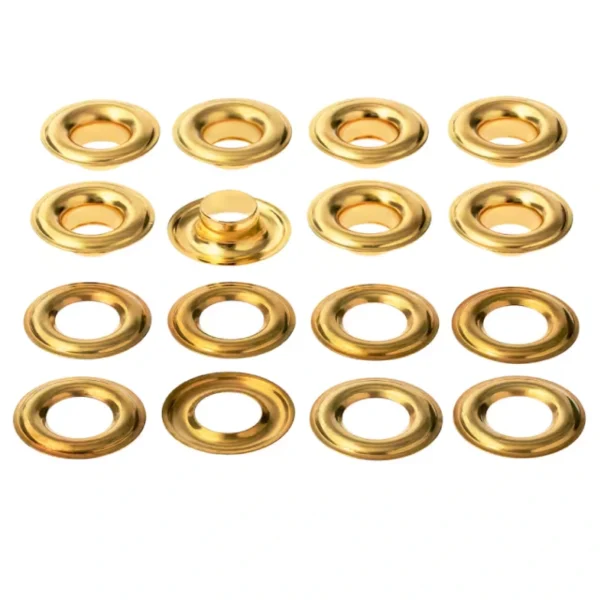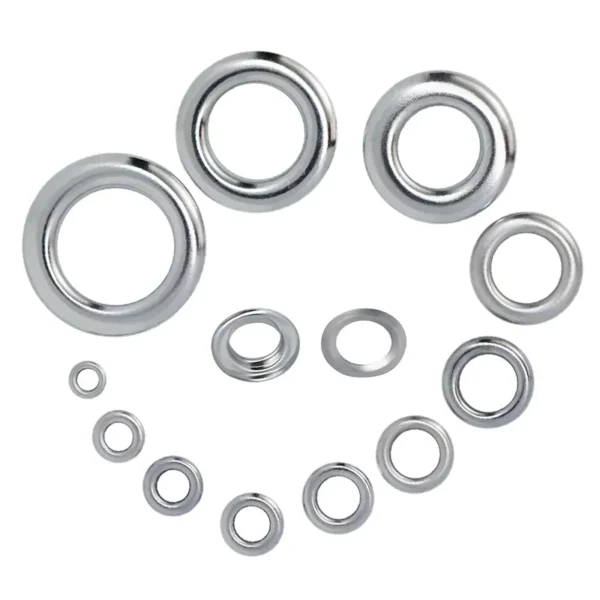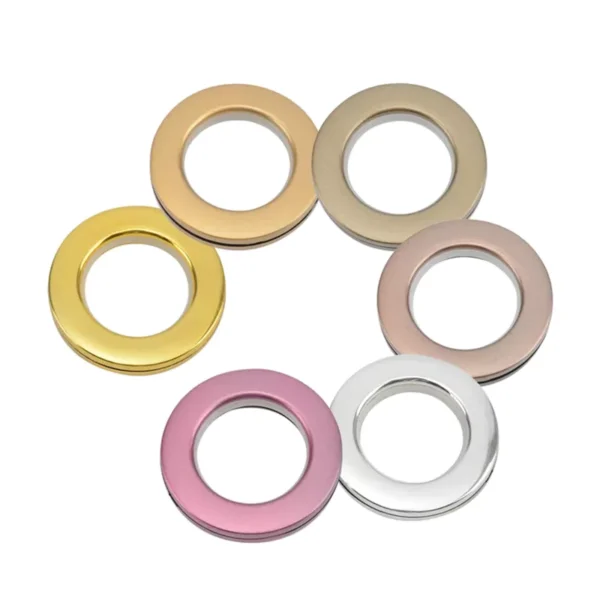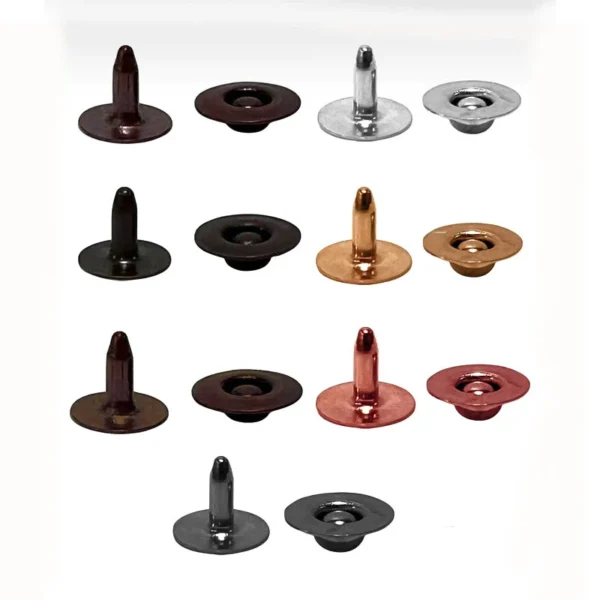Eyelets are round, metal rings used to reinforce holes in fabric. They’re most commonly used in garments, accessories, and home décor items to provide a neat finish and reinforce areas where cords or laces are threaded through. Installing eyelets correctly can elevate the appearance of your project, adding both functionality and style.
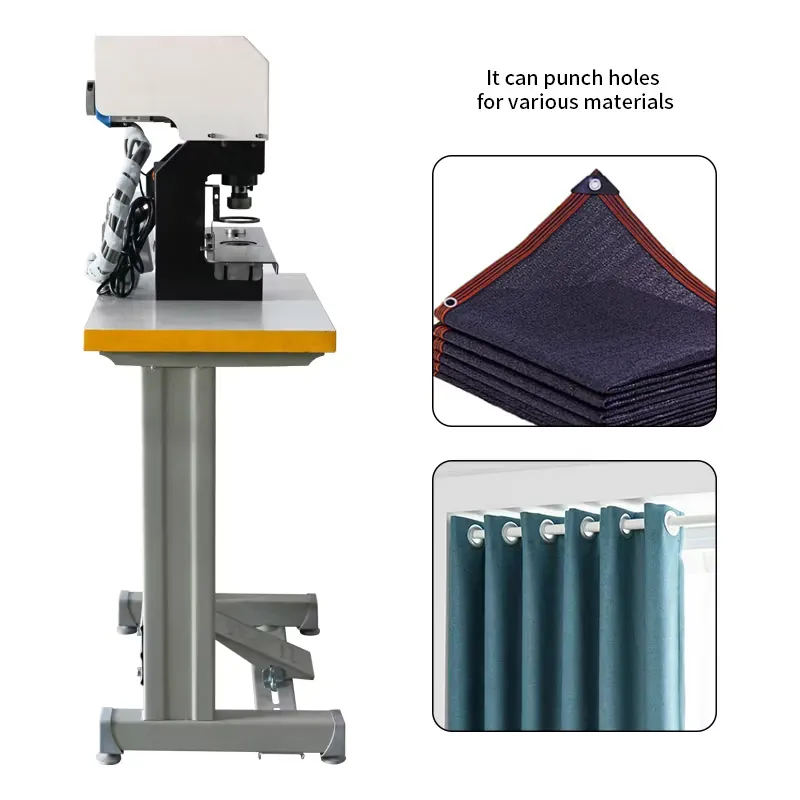
What Are Eyelets?
Eyelets are small metal rings with a hole in the center. They’re often used to make holes for laces or cords, typically found in shoes, garments, and tents. The metal ring ensures the fabric doesn’t tear around the hole, adding strength and stability.
Why Use Eyelets in Fabric?
Eyelets provide both aesthetic and functional benefits. Not only do they help to prevent fabric from fraying and tearing, but they also create a clean and professional appearance. Eyelets are commonly used in projects like:
- Clothing: for lacing and closures in corsets, shoes, and athletic gear.
- Home décor: for curtains, blinds, and decorative panels.
- Crafts and accessories: like tote bags, jewelry, and wallets.
Tools Needed to Make Eyelet Holes in Fabric
To make eyelet holes in fabric, you’ll need the right tools. The process is relatively simple, but the right equipment is essential for accuracy and durability.
Eyelet Tools Overview
There are several tools available for making eyelet holes, from manual tools to automatic machines. Some of the most commonly used tools include:
- Handheld Punch and Die Set: This set allows you to manually punch holes in fabric and install eyelets.
- Automatic Eyelet Machine: Used for higher volume or professional-level projects, this machine does both the punching and setting of eyelets.
- Hammer and Eyelet Setter: Used for inserting eyelets into fabric after punching.
Selecting the Right Eyelet Tools
Choosing the right tool depends on the scale of your project. For small, DIY projects, a handheld punch and die set may be sufficient. However, for larger or professional projects, an automatic eyelet machine might be necessary.
Where to Buy Eyelet Tools
You can purchase eyelet tools from craft stores, sewing supply shops, or online marketplaces like Amazon and eBay. Be sure to select tools that are compatible with your fabric type and eyelet size.
What Is an Automatic Eyelet Machine?
Automatic eyelet machines are specialized tools designed to streamline the process of making eyelet holes in fabric. These machines perform both the punching and setting of eyelets, ensuring that each hole is perfectly sized and securely fastened. Whether you’re working with lightweight fabrics for garments or heavier fabrics for home décor, automatic eyelet machines offer a professional finish that is difficult to achieve with manual tools.
An automatic eyelet machine is a mechanical device that uses a combination of pressure, force, and precision to install eyelets into fabric. These machines come in various models, each designed to handle different fabric types and eyelet sizes. The most advanced machines can also handle multiple eyelets simultaneously, making them ideal for high-volume production environments.
Why Use an Automatic Eyelet Machine?
Using an automatic eyelet machine eliminates many of the challenges associated with manual eyelet installation, such as inconsistent hole size, uneven placement, or fabric damage. The key benefits include:
- Speed: Automatic machines significantly reduce the time it takes to install eyelets compared to manual methods.
- Precision: The machine ensures that each hole is cut to the correct size and the eyelet is securely set every time.
- Consistency: For large projects, automatic machines guarantee uniformity across all eyelets, crucial for professional results.
- Less Fabric Damage: The machine minimizes the risk of stretching or tearing fabric, which can happen with hand tools if not handled properly.
How Does an Automatic Eyelet Machine Work?
Understanding the mechanics of an automatic eyelet machine can help you appreciate its efficiency. Here’s a breakdown of how the process works:
Step 1: Fabric Placement
To start, the fabric is positioned under the machine’s eyelet press. Some machines are equipped with a feeder system that automatically places the fabric in the correct position, while others require manual alignment.
Step 2: Marking the Eyelet Spot
Unlike manual methods, automatic eyelet machines often have a built-in system that marks the exact spot where the eyelet will be placed. This ensures precise alignment and spacing of the eyelets across the fabric.
Step 3: Punching the Hole
Once the fabric is in position, the machine uses a punch mechanism to create a clean hole in the fabric. The hole is typically just slightly smaller than the eyelet’s diameter to ensure a tight fit when the eyelet is inserted.
Step 4: Inserting the Eyelet
After the hole is made, the machine automatically inserts the eyelet. The machine uses a set of dies to secure the eyelet, which are pressed together to “set” the eyelet into the fabric.
Step 5: Final Adjustment
Once the eyelet is installed, the machine checks for proper alignment and tightness. If necessary, it adjusts the eyelet to ensure it’s securely fastened without damaging the fabric.
Types of Automatic Eyelet Machines
There are different types of automatic eyelet machines designed for specific needs. Here are some common types:
1. Single-Head Automatic Eyelet Machines
These machines are ideal for smaller-scale projects or for use in production environments where each eyelet installation requires a high level of precision. They work well for lightweight fabrics and smaller batches of items like garments or accessories.
2. Multi-Head Automatic Eyelet Machines
For large-scale operations, multi-head machines can insert multiple eyelets at once. This type of machine is commonly used in industrial settings where efficiency and speed are essential, such as in the production of curtains, blinds, or tents.
3. Pneumatic Eyelet Machines
Pneumatic machines use compressed air to apply pressure during the installation of the eyelet, providing consistent force with minimal physical exertion. These machines are often used in larger production facilities due to their high output capacity.
4. Hydraulic Eyelet Machines
Hydraulic machines are heavier-duty and capable of handling tougher fabrics and larger eyelets. They are often used in the manufacturing of products like leather goods or canvas tents, where durability is paramount.
Choosing the Right Fabric for Eyelets
Before installing eyelets, it’s important to choose the right fabric to ensure the eyelets hold securely. Some fabrics are better suited for eyelet installation than others.
Best Fabrics for Eyelet Installation
- Cotton and Cotton Blends: These fabrics are easy to work with and hold eyelets securely.
- Denim and Canvas: Heavy fabrics like denim and canvas provide a strong base for eyelets.
- Leather: Leather can be used for eyelets but requires special tools to avoid damage.
Fabrics to Avoid When Installing Eyelets
- Stretchy Fabrics: Materials like jersey or spandex can stretch and distort around the eyelet hole.
- Delicate Fabrics: Silks and sheers may tear easily, even when reinforced, and might not hold the eyelet well.
Step-by-Step Guide: How to Make Eyelet Holes in Fabric
Now that you have the right tools and fabric, let’s dive into the detailed process of installing eyelets.
Marking the Placement of Eyelets
Before you start making eyelet holes, it’s crucial to mark where they should go. Use a fabric marker or chalk to carefully mark the exact spot for each eyelet. Ensure the spacing is even and consistent.
Preparing the Fabric for Eyelet Holes
To prepare your fabric:
- Iron the fabric to remove wrinkles.
- Stabilize the fabric if it’s lightweight by using fusible interfacing or stabilizer.
- Cut the fabric to your desired size and shape.
Cutting the Hole for the Eyelet
Using a fabric hole punch or a sharp pair of scissors, carefully cut a hole where you marked the fabric. The hole should be slightly smaller than the diameter of the eyelet to ensure a snug fit.
Installing the Eyelets: A Detailed Process
Once the hole is cut, it’s time to install the eyelet. Here’s a breakdown of the process:
Using a Hand Punch Tool
- Place the fabric on a sturdy surface.
- Align the eyelet over the hole.
- Insert the eyelet setter on one side of the fabric and hammer it down to secure the eyelet in place.
Using an Automatic Eyelet Machine
- Insert the fabric into the machine, aligning the hole with the eyelet attachment.
- Set the eyelet into the machine and press the foot pedal or handle to install the eyelet securely.
Setting the Eyelet: Tips and Techniques
Once the eyelet is installed, make sure it’s securely fastened by checking both sides of the fabric. If the eyelet is loose, use a setting tool to tighten it further.
Common Mistakes When Making Eyelet Holes in Fabric
While the process is straightforward, there are a few common mistakes to avoid:
Overstretching the Fabric
Be cautious not to stretch the fabric while inserting the eyelet, as this can cause the fabric to lose its shape or make the hole too large for the eyelet.
Misplacing the Eyelet Hole
Accurate marking is crucial. Double-check the placement of the hole before cutting, as misplacement can affect the functionality and appearance of your project.
How to Secure and Reinforce Eyelets in Fabric
To ensure long-lasting durability, reinforce the fabric around the eyelet.
Reinforcing Fabric Around Eyelets
You can use fusible interfacing or fabric glue to reinforce the fabric. This helps prevent the fabric from tearing or fraying around the eyelet.
Tips for Preventing Fraying
To prevent fraying, consider using pinking shears around the hole or applying a small amount of fabric sealant to the edges.
Maintenance of Eyelet Tools
To keep your tools in good condition, proper maintenance is essential.
Cleaning and Caring for Your Eyelet Tools
Regularly clean your punch and die tools to remove fabric residue. For automatic machines, follow the manufacturer’s instructions for maintenance.
Storing Your Eyelet Tools Properly
Store your eyelet tools in a dry, cool place to prevent rust and wear. Keep them in a protective case to avoid damage.
Applications of Eyelets in Fabric
Eyelets can be used in a wide variety of projects, enhancing both the function and appearance of your designs.
Eyelets in Clothing and Accessories
From corsets to shoes, eyelets are often used to reinforce holes for laces, adding both visual appeal and structural integrity.
Eyelets in Home Décor
Eyelets are commonly used in curtains, drapery, and fabric panels, allowing cords or rods to be threaded through for easy installation.
FAQs
Can I install eyelets without special tools?
While it’s possible to install eyelets by hand with basic tools like a hammer and punch, using specialized tools ensures better accuracy and durability.
What types of fabrics are best for eyelets?
Heavy fabrics like denim, canvas, and cotton blends work best for eyelets, as they provide strong support for the metal rings.
How do I prevent fabric from fraying around the eyelet hole?
Reinforce the area with fusible interfacing or fabric sealant, and use pinking shears to cut around the hole.
Can I make eyelet holes in stretchy fabrics?
Stretchy fabrics can be tricky, as they may distort the hole. Use a stabilizer and reinforce the fabric before installing eyelets.
Do I need to reinforce the fabric before installing eyelets?
It’s recommended to reinforce lightweight or delicate fabrics with interfacing or stabilizer to prevent tearing and ensure the eyelet stays secure.
How do I remove eyelets if I make a mistake?
To remove an eyelet, use pliers or an eyelet removal tool. Be gentle to avoid damaging the fabric.
Conclusion: Mastering Eyelet Hole Installation
Learning how to make eyelet holes in fabric is a valuable skill for any fabric enthusiast. Whether you’re a beginner or an experienced crafter, this guide provides everything you need to successfully install eyelets in your fabric projects. With the right tools, fabric, and techniques, you’ll be able to create durable and stylish projects every time.

